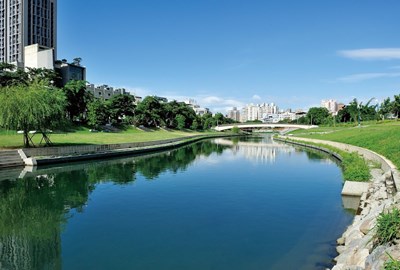
A nostalgic bikeway excursion in Dali Transitioning from Tailikhit to Dali Art
Words by Tsai Chin-ding
Translated by Anna Yang
Photos by Reflection Photography
At the mention of Taichung's Dali District, many people tend to think of repair shops and industrial factories, or the Guoguang Flower Market. However, its recently-opened Dali Art area at Taichung Software Park has been growing in popularity and, in fact, Dali itself has a long and abundant cultural history. This makes it a perfect time to enjoy a riverside bicycle tour and explore a nostalgic part of this district.
Dali is Taichung's third-largest district (after Beitun and Xitun districts) and located in the city's southeastern side. Its geography includes both plains and mountains. To the east is the mountain area of Wufeng (also known as Pitou Mountain) and to the south is Chaohu Creek, around an area originally settled by immigrant's of the Lin Family (one of Taiwan's largest historic families) from Fujian Province. This included, for example, Lin Shuan-wen, a revolutionary leader who was captured and sentenced to death during the Qing Dynasty.
As Dali culture and history researcher Ruan De-yang notes, "Dali's development is closely intertwined with rivers." So let's take a ride along a river on a Taichung iBike to explore a nostalgic part of Dali.
The ever-changing Hanxi River: Taichung's Cambridge Riverbank Park
The Dali basin's three main rivers are the Han River, Dali River and Chaohu Creek, flowing through the district from east to west. Sustainable watershed development of Taichung waterways, including Liuchuan Canal in Central District, is well-managed and has attracted tourists' attention. Dali's Cambridge Riverbank Park (the Old Han River) once flowed beneath Guoguang Bridge and is today a must-visit tourist destination. Multitudes of visitors visit the park throughout the day, from young couples strolling through the the attractive scenery at night to daytime fishermen. Free canoe rides here are also quite a draw.
Also unforgettable is a 22.8-meter-tall 228 Incident monument that stands here, decorated with metal lotus petals interspersed with 56 cranes symbolizing peace and harmony. Dali native, famous writer and Japanese colonial era politician Chen Wen-huan (1909-1978) served as Dali Village chief at the end of the Japanese period and later became Taichung County's first legislative representative. In the wake of the 228 Incident, fear, disillusionment and a strict ban on free expression led him to stop writing, and he also became a victim of the incident.
Niaochuwei Park
Located by the Old Han River (like the new Cambridge Riverbank Park), this park is filled with natural, eco-friendly features and attractions. The clever daily-living skills of earlier generations here included using sharpened bamboo to protect the village from outsiders and the use of bamboo as a main resource for making furniture and houses. The bamboo groves here were thick enough to prevent intruders but attracted nesting birds, thereby giving this place its name of "Niaochuwei" ("birds nesting in a wall of bamboo"). Even now, birds visit the fish-filled river to enjoy an abundant meal. Resident riverside farms here also have attracted butterflies and other insects, providing beautiful eco-friendly scenes for visitors.
Jinshi Park (Scholar's Park)
At the western edge of Cambridge Riverbank Park is ShuangWen Road--the route of escape for Lin Shuang-wen as he fled from Changhua to Dali, Nantou and Shueishalian after a failed anti-Qing Dynasty uprising. Thus, some people also know it as "Rebellion Road" because of its use by rebels against the Qing-appointed Taiwan governor. As you head south on ShuangWen Road, you will come to Jinshi Park, located at the intersection of DeFeng Road, Sec. 2 and ShuWang Road. A monument in this park notes, "Lin Sheng-tang's (head leader of the Lin Family) father was honored as a scholar in 1893 and lived a life of seclusion from 1854 to 1900". Although many believe that the Lin Family was established in Wufeng, its first generation in fact started with Lin Shi-ding, who resided in Tailikhit (see below) with later generations then moving to Atabu (Wufeng) after the anti-Qing rebellions.
Liangshan Shuwang (King of Trees)
Heading towards ShuWang Road from the northwestern side of Jinshi Park will bring one to clusters of trees by Luchuan River and the Old Han River, including a century-old red cedar surrounded by other trees. Ruan notes that some of Taiwan's earliest land settlement took place in central Taiwan during the Qing Dynasty, with "Liangshan Shuwang" land development being carried out by Lang and Xin (military officials) and later becoming a flourishing village.
According to locals, the Shuwang (King of Trees) area has three treasures: Wanan Temple, the Shuwang deity, and water spinach. The Shuentien god and Shennong deities are worshiped at Wanan Temple and led the Changchu Lin clan to the Liangshan Shuwang area to establish a village there. The clan also established Ancestor Lin's Shaofu Hall as a place for later generations to honor their ancestors. The Zhongtze (ancestral hall) painting was completed by young artist Jiangfeng with delicate brush strokes.
Life along historic Tailikhit Street
As you walk south on ShuangWen Road and make a left turn on DaLi Road, there's the old street village. Tailikhit (Da-li-yi) is a transliterated Taiwanese Plains Aborigine name, with the plural "yi" referring to a wooden bit for securing a boat with rope. Earlier ancestors gave this name to Dali because it was once flourished with shipping-related businesses.
Tailikhit, Litoudian (Nantun) and Sichangli (Beitun) were all sizable areas in the past. The street between the Fuxin Mazu Temple and harbor was filled with shops, including cloth-dyeing stores, restaurants, grocery stores and pharmacies, giving it the local moniker of "Shop Street". This once-flourishing area later faded after XiShui Road was moved south due to traditional "feng-shui" beliefs.
As you walk down the old street along the river, the nostalgic Chingyuantang--an old shop once run by the Lin Family--embodies the prosperous past with its classic exterior. During the Qing Dynasty's Qianlong period, the main religion in Fujian Province was Fuxing Mazu, with Fujian people following Mazu from the late 18th century. The above-mentioned Lin Shuang-wen was among Mazu worshippers and led an anti-Qing uprising to protect local people.
Although the Tailikhit Community Center on XinXing Road today has no exhibits about past local heroes, it was a venue for meetings and discussions by activists and leaders during the Japanese colonial period. This Japanese-style building, built in 1929, has served as a local community center as well as a current-day exhibition hall introducing local history and culture.
Legendary Chaohu taro ice
Heading south toward Chaohu Creek will lead to an encounter with Chaohu taro ice, a favorite dessert during the 1950s and '60s. Popular nationwide, Taiheyuan (named after a store) Taro Ice has its own unique characteristics and has been around throughout the decades of Taiwan's industrial transformation.
Another shop, Lin Family's Meifang Taro Ice, was opened in 1974 by an owner who was once a farmer. Its taro ice became famous along Taiwan Provincial Highway No. 3. New roadways meant that ripe taro could be easily transported to Dali from Dajia and many government workers would stop in on their way to and from work. The owner was known for avoiding any chemicals additives in his desserts and for storing ice in polystyrene containers to keep it cold. Chaohu taro ice grew even more popular as more shops opened following completion of the national highway in 1978. However, today's taro ice business has since declined due to competition from imported ice cream, leaving only 2-3 shops that still offer this all-natural, traditional treat in the Chaohu area.
A new Dali highlight
When you visit Donghu Park, Taichung Software Park on ZhongXing Road is right next door. Once a Taiwan Tobacco and Liquor Corporation laboratory, it is now a culture and creative attraction that draws culture and creative industrial representatives developing concepts that creatively promote local agricultural products. New tourism spotlight Dali Art has an exhibition center and restaurant that welcomes visiting tourists, and a preserved Japanese-style office has been transformed into an exhibition space used by Taichung Software Park to showcase local traditional and modern industrial heritage.
Wufeng is right on the other side of Chaohu Creek and, as you bike north toward ZhongXing Road, the Taiwan Printing Discovery Center can be seen. This place used to print business receipts but, with the growing trend toward electronic receipts, has now been turned into a tourist factory.
As you go north and reach Dali Sports Park on ShengLi 2nd Road, you will see another new attraction, the Museum of Fiber Arts, once a children's art hall. Although the museum is not yet open, its handicraft promotions have drawn the attention of many families. For community residents, the sports park is also a good place to exercise. This location was once a water basin before that was moved to southern Dali and the site was turned into a grassland. Here you can also see the old water way heading toward old streets of Tailikhit.

 Facebook
Facebook
 Twitter
Twitter
 LINE
LINE